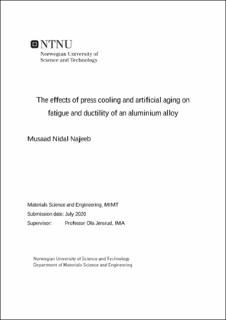| dc.description.abstract | Den moderne bilindustrien krever nye løsninger når det gjelder å produsere lette kjøretøyer for å redusere utslipp og øke drivstoffeffektiviteten. Utherdbare aluminiumslegeringer er attraktive erstatninger for stål for å redusere vekten på kjøretøyer. Utherdbare aluminiumslegeringer kombinerer høy styrke og god duktilitet. I denne studien ble det brukt to utherdbare aluminiumslegeringer, AA6082og AA6010, som tilhører AA6-xxxx-serien. Under varmebehandlingen ble det brukt en integrert in-die quenching og varmeformingsmetode. Denne metoden er mer egnet for høyvolumproduksjon enn den konvensjonelle produksjonsprosessen. Et forbedret flatpresse-verktøy ble brukt til å deformere og slukke prøvene etter oppløsningsvarmebehandling.
Det siste trinnet i varmebehandlingsprosedyrene var kunstig aldring. Legeringer ble testet til tre tilstander med den kunstige aldringen; under-aldret, topp-aldret og over-aldret tilstander. Under de mekaniske testene var utmattelsesatferd med lav syklus hovedfokus. Etter kunstig aldring får utherdbare aluminiumslegeringer bedre styrke og lavere duktilitet. Derfor ble det utført utmattelsestester med lav syklus for å skille sammenhengen mellom styrke og duktilitet, og for å sammenligne mellom under-aldrede, topp-aldrede og over-aldrede tilstandsresultater. Effekten av den kunstige aldringen på egenskapene med lav utmattelse ble studert ved å utherde prøvene til tre forskjellige perioder. For AA6082 ble prøvene delt inn i tre grupper. Den første gruppen av prøver ble kunstig aldret i 40 minutter til under-aldret tilstand, den andre gruppen av prøver ble kunstig aldret i 3 timer til topp-aldret tilstand, og den siste gruppen av prøver ble kunstig aldret i 8 timer til overaldret tilstand. For AA6010 er den samme prosessen blitt utført. Men periodene med den kunstige aldringen var 2 timer for under-aldret tilstand, 5 timer for topp-aldret tilstand og 20 timer for over-aldret tilstand. Resultatene viser at prøver med høyere strekkfasthet har lavere utmattelses-levetid. Over-aldret tilstand tåler høyest antall sykluser før at det skjer brudd i prøven. | |
| dc.description.abstract | The modern automotive industry demands new lightweight solutions regarding producing light vehicles to reduce gas emissions and increase the fuel-efficiency. Age hardenable aluminium alloys are attractive choices to replace the steel to reduce the weight of vehicles. Age hardenable aluminium alloys combine high strength and good ductility.
In this study, two age hardenable aluminium alloys AA6082 and AA6010 that belong to AA-6xxx series have been used. During the heat treatment, an integrated in-die quenching, and hot forming method was used. This method is more suitable for high volume production than the conventional production process. An improved flat pressing tool was used to deform and quench the samples after solution heat treatment.
The last step of the heat treatment procedures was the artificial aging. Three different states of the artificial aging have been tested: under-aged condition, peak-aged condition, and over-aged conditions.
During the mechanical tests, low cycle fatigue behavior was the main focus. After artificial aging, age hardenable aluminium alloys get better strength and lower ductility. Therefore, low cycle fatigue tests were done to distinguish the relation between the strength and ductility, and to compare between the under-aged, peak-aged, and over-aged condition results. Effect of the artificial aging on the low fatigue properties was studied by aging the samples to three different periods. For AA6082, samples were divided in three groups. The first group of samples was artificially aged for 40 minutes to the under-aged state, the second group of samples was artificially aged for 3 hours to the peak-aged for state, and the last group of samples was artificially aged for 8 hours to the over-aged state. For AA6010, the same process was done. The periods of the artificial aging were 2 hours for the peak-aged state, 5 hours for the peak-aged state and 20 hours for the over-aged state. Results exhibit that samples that have the higher tensile strength have the lower fatigue life. The over-aged condition gives the higher number of cycles to failure. | |
